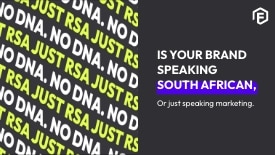South African Heritage Month Campaigns That Got It Right and Why
Heritage Month in South Africa is a curious thing. Officially, it honours the nation’s diverse cultures, traditions, and histories, offering a rare opportunity to reflect on identity. Unofficially, it is a four-week-long reminder for marketers that their attempts at cultural relevance will be scrutinised online. Some campaigns soar, others crash and burn, leaving hashtags that live on only as cautionary tales.Discover some of the campaigns that actually got it right. Not only did they acknowledge the significance of Heritage Month, but they also respected South Africa’s complexity – a country with so many native identities that even the most well-intentioned brand risks generalisation. And yet, these campaigns found ways to honour the nation’s heritage while still being engaging and memorable.
Understanding Heritage Month
Heritage Month falls in September, culminating in Heritage Day on the 24th. The day was officially instituted to transform 24 September – once “Shaka Day” in KwaZulu-Natal – into a national celebration recognising all of South Africa’s cultures. The goal: unity without erasure, acknowledgement without tokenism.Why does it matter to marketers? Because Heritage Month is more than a marketing calendar. It is an occasion when South Africans expect brands to be aware of cultural context, creative in their execution, and, most importantly, genuine. Anything else risks ridicule – or worse, being ignored.
Case Study One: Castle Milk Stout – “Don’t Let Their Stories Disappear”
Castle Milk Stout approached Heritage Month with a level of gravitas unusual for beer marketing. They invited South Africans to share ancestral stories, preserving oral traditions in a digital age. The brilliance lay in the execution:The takeaway? Give the audience ownership, and authenticity emerges naturally. Heritage becomes more than a motif – it becomes a living narrative.
Case Study Two: Tastic x Thandiswa Mazwai
Tastic rice, a staple in South African kitchens, could have relied solely on “Heritage Month” packaging – a tempting but hollow tactic. Instead, the brand collaborated with Thandiswa Mazwai, a South African musician whose work embodies cultural depth and contemporary relevance.The result:
Social media content that felt like a cultural conversation rather than a corporate monologue.
Lesson learned: partnerships with cultural voices matter. Without Mazwai, the campaign would have been rice with a sticker – with her, it became identity in a packet.
Case Study Three: Tshepo Jeans – “We, The People”
Tshepo Jeans took a bold approach. They printed the opening words of the South African Constitution across T-shirts in all 12 official languages. A campaign that was simultaneously serious and shareable:This campaign worked because it treated heritage as a statement, not decoration. It demonstrated that respecting symbols and making them visually digestible can resonate across generations.
Case Study Four: Takealot Heritage Design Challenge
In a brilliant twist on packaging, Takealot invited young designers to submit Heritage Month-inspired artwork for delivery boxes. Customers weren’t just receiving products – they were receiving miniature cultural exhibitions.Why it worked:
Community co-creation brought authenticity.
Local artists were spotlighted, amplifying voices rather than speaking over them.
- Heritage was celebrated in an unexpected space: the last metre of a delivery journey.
- Even when the campaign involved beer, it respected the ritual, the gathering, and the shared moments – a masterclass in cultural relevance.
- Participation over presentation: South Africans engaged actively – sharing stories, remixing content, attending activations – rather than passively consuming advertising.
- Balance of tradition and trend: These campaigns honoured history while making it digestible, visual, and digital-native-friendly.
- Unity without erasure: Celebrating differences while highlighting commonality strengthened social cohesion – the heart of Heritage Day’s purpose.
- Wit and relatability: Clever execution without over-sentimentality helped the campaigns avoid patronising audiences while still delighting them.
- Collaborate with cultural voices – authenticity cannot be faked. Let the audience participate – co-creation is better than broadcast.
- Keep digital at the forefront – shareable, interactive, and remixable content works best.
- Respect diversity within national identity – celebrate difference without flattening complexity.
- Be witty, self-aware, and slightly irreverent – audiences respond to humour that acknowledges rather than patronises.
Case Study Five: Castle Lager – The World’s Biggest Braai
Castle Lager leaned into the most South African of traditions: the braai. Their “World’s Biggest Braai” campaign celebrated community, food, and the simple truth that shared experiences unite.Success factors:
Recognising a familiar cultural practice rather than inventing a new one. Creating a participatory, nationwide activation.
Using humour and approachable storytelling to make the brand feel human.
Why These Campaigns Worked
They treated heritage as lived, not decorative: Real stories, real traditions, and real voices, rather than token motifs.Lessons for Marketers
Heritage Month is not a gimmick. Missteps are visible, viral, and enduring. The campaigns that succeed demonstrate key strategies:Conclusion: Celebrating Heritage, Successfully
South African Heritage Month campaigns succeed when they treat culture as living, contested, and participatory. Brands that celebrate heritage thoughtfully can build engagement, trust, and social relevance.Heritage Month is about identity, unity, and, sometimes, a reminder that even beer ads can teach us a little about the country we share. The campaigns that work don’t just market heritage – they participate in it. And in a nation as diverse and proud as South Africa, that distinction is everything.
P.S. Don’t forget to share this article.
Flume is an independent, full-service digital marketing agency providing services that include SEO, web design and development, public relations, media buying, client service, UX/UI, and creative production. For more information visit www.flume.co.za or email us at [email protected] to say, well, “hello”.
-
Frequently Asked Questions
-
1. Why are people using TikTok as a search engine instead of Google?
- TikTok has become a search engine for many, especially younger generations, because it delivers authentic, user-generated content through short-form videos. Unlike Google’s webpage indexing, TikTok offers answers rooted in lived experiences, complete with visuals and personal commentary, making it feel more relatable and trustworthy for queries like tutorials, reviews, or recommendations.
-
2. How is AI changing the way we search?
- AI-powered search tools like ChatGPT and Perplexity provide direct, synthesised answers instead of lists of links. They act like a concierge, understanding user intent and delivering contextualised responses, which shifts search from link-based discovery to instant answer delivery, challenging traditional SEO strategies.
-
3. Is Google still relevant with the rise of TikTok and AI search tools?
- Yes, Google remains a powerhouse for research-heavy and transactional queries, backed by decades of data and robust infrastructure. However, it’s adapting to competition from social platforms like TikTok and AI tools by introducing features like Search Generative Experience (SGE) to provide direct answers.
-
4. What does the shift to social and AI search mean for digital marketers?
Marketers must adopt multi-platform, multi-format strategies. This includes creating answer-focused content for AI, producing short-form videos for platforms like TikTok, leveraging user-generated content for trust, and optimizing for clear, natural language to align with AI discovery.
-
5. Can we trust AI search engines to provide accurate information?
- AI search engines are improving but can still produce inaccuracies or overconfident responses, sometimes referred to as “hallucinations.” While they’re powerful for quick, synthesised answers, users should verify critical information, especially for complex or sensitive queries.



